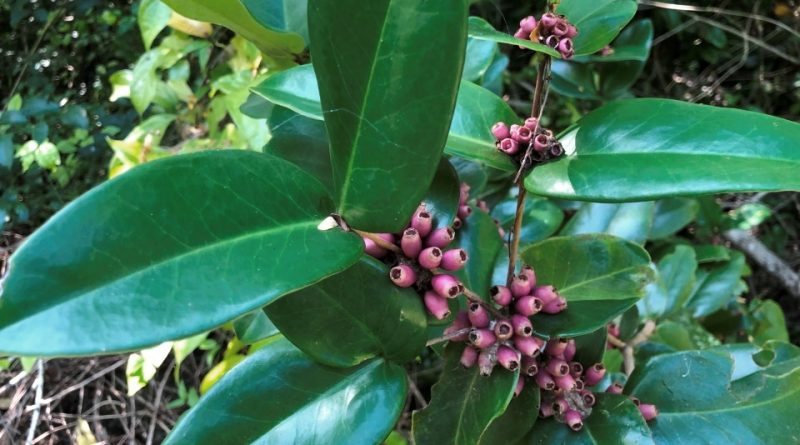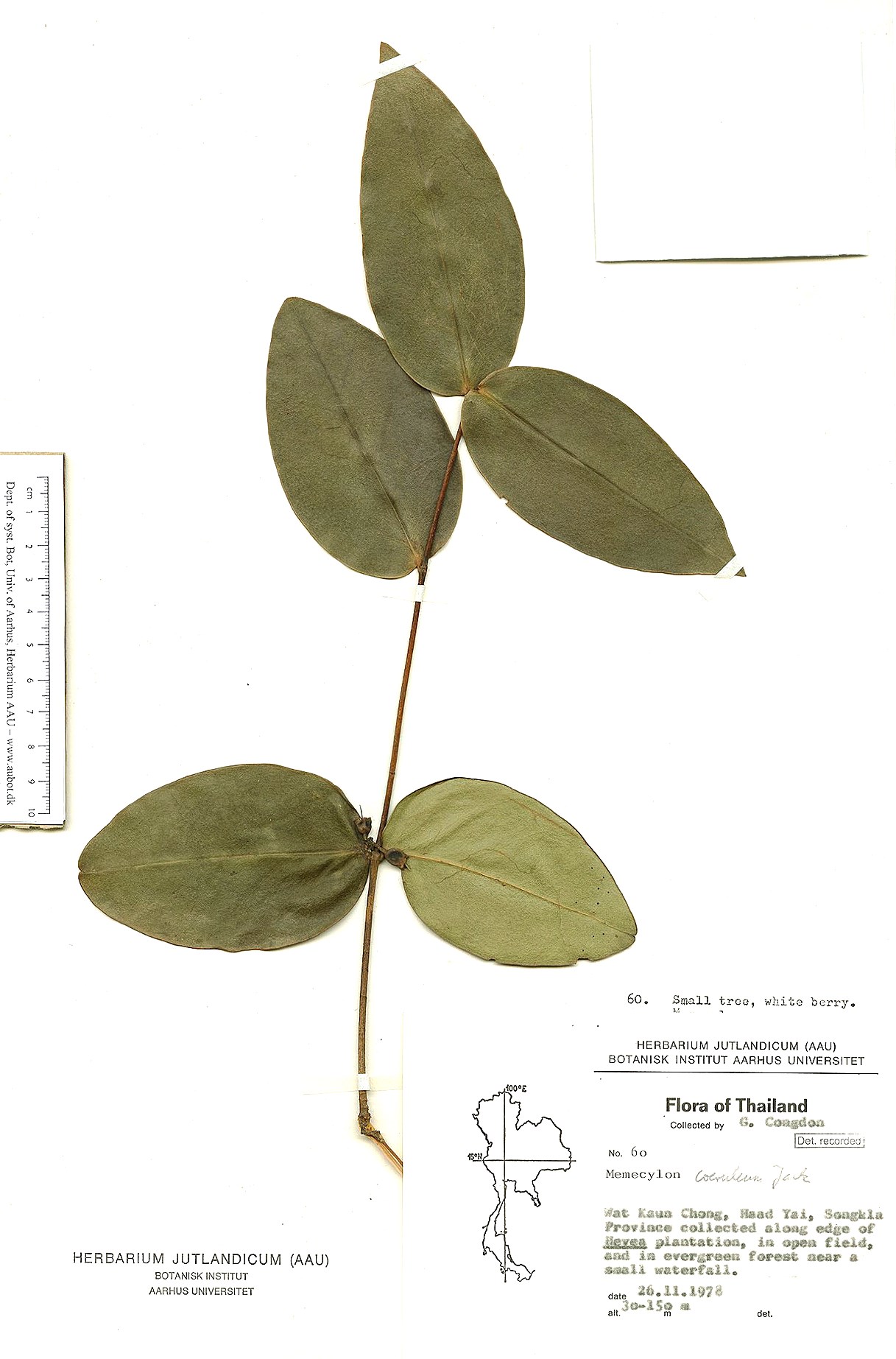Memecylon caeruleum
Memecylon caeruleum
The Javanese nipis or blue strawberry flowers (Memecylon caeruleum Jack 1820) is a shrub species belonging to the Melastomataceae family.
Systematic –
From a systematic point of view it belongs to:
Eukaryota domain,
Kingdom Plantae,
Subkingdom Tracheobionta,
Spermatophyta Superdivision,
Division Magnoliophyta,
Class Magnoliopsida,
Subclass Rosidae,
Order Myrtales,
Family Melastomataceae,
Genus Memecylon,
Species M. caeruleum.
The terms are synonymous:
– Memecylon floribundum Blume (1851);
– Memecylon cyanocarpum C.Y. Wu ex C. Chen (1979).
Etymology –
The term Memecylon derives from the name given by Dioscorides (circa 40 – circa 90 AD) to Arbutus unedo.
The specific epithet caeruleum comes from the Latin “caeruleus, a, um”, i.e. blue, in reference to the color of the flowers.
Geographic Distribution and Habitat –
Memecylon caeruleum is a plant that grows from New Guinea, west through Southeast Asia to Tibet, Zhōngguó/China.
The species grows natively in an area from New Guinea, through Malaysia to parts of Zhōngguó/China. The countries and regions where she was recorded as native are: Papua New Guinea (mainland); Indonesia (West New Guinea/West Papua, Moluccas, Sulawesi, Kalimantan, Jawa, Sumatra); Philippines; Malaysia (Sabah, Sarawak, Peninsular Malaysia); Singapore; Cambodia; Vietnam; Laos; Zhōngguó/China (Hainan, Yunnan, Tibet); Myanmar; and India (Andaman Islands, Nicobar Islands). It has also been introduced to the Seychelles where the plant has also become an invasive species.
As regards its habitat, the plant grows in secondary formation in south-east Asia. In China its presence is documented in sparse (open forests) to dense (closed) forests, at approximately 900-1200 m above sea level.
Mount Malindang is a volcano on the island of Mindanao, Philippines. In secondary forests on the slopes, at about 1650 m altitude, the tree is described as rare but common in scattered areas by local experts, while it is described as economically important by experts at the National Museum of the Philippines.
On the slopes of Nglanggeran volcano, Gunung Kidul regency, Indonesia, the shrub dominates forests on arid lands and is commonly associated with Ardisia javanica, Pavetta species, Melastoma malabathricum and Psychotria species.
The plant also grows along the Mekong River in Kratie and Steung Treng provinces, Cambodia. It grows in river beaches, bamboo and deciduous forests, and mixed evergreen and deciduous forest communities, on both metamorphic and shale-derived sediments at altitudes between 25 and 30 m.
On the island of Mahé, in the Seychelles, the non-native plant was first reported in 1931. Since then its range has expanded to cover a considerable area and has moved as far as the nearby island of Praslin. This plant produces dense shade and the associated floral community has low diversity. The faunal communities that populate the areas infested by shrubs are mainly made up of cosmopolitan taxa, among which the most abundant is the Technomyrmex albipes-Icerya seychellarum association (ants and coccoid bugs/cochineals, in the immature fruit). The shrub poses a significant threat in degraded habitats.
Description –
Memecylon caeruleum is a plant that grows in the form of a shrub or small evergreen tree, 3-8 m tall, with a cylindrical trunk and smooth, brown bark in the young branches, wrinkled and greyish in the older ones.
The leaves are located on a 3-6 mm long petiole, are opposite, simple, oblong-elliptical with acute, obtuse or retused apex and entire margin, 8-16 cm long and 3-6 cm wide, leathery, dark green in color and shiny on top.
The inflorescences are on a peduncle 0.5-1 cm long; they are axillary, compact, 1.5-3 cm in diameter, bearing numerous tiny flowers with cup-shaped hypanthium, 3-4 mm long, 4 sepals, 4 ovate petals, 2-3 mm long, externally red, intense blue internally, and 8 stamens, about 2.5 mm long, blue in colour.
The fruits are obovoid in shape, about 1.5 cm long and 1 cm in diameter, initially pink to red in colour, then blackish purple or black when ripe, edible.
Inside there is generally a single seed immersed in a juicy purple pulp.
Flowering occurs from April to August, fruiting in December and January. In Cambodia, the species flowers in July and bears fruit from October to May.
Cultivation –
Memecylon caeruleum is an evergreen shrub or small tree, which is collected in the wild for local use as food, and possibly also for its wood.
It is a rather attractive plant due to the foliage and the tiny, intensely colored flowers produced for most of the year. It can be used as an isolated specimen, for hedges and borders, bearing pruning well, and in street trees in parks and gardens in climate regions. tropical and subtropical.
For its cultivation it requires full sun or light shade and fertile, well-drained soils, kept almost constantly humid; it tolerates moderately salty soils and marine aerosols, and can therefore be grown near the sea.
Reproduction occurs easily by seed in a fertile substrate, with the addition of 30% sand to improve drainage, kept humid at a temperature of 26-28 °C; it is also propagated by cuttings and layering.
Customs and Traditions –
Memecylon caeruleum is a plant known by various common names: among these we remember: blue strawberry flowers, Javanese nipis (English); phlong ka-ek (Cambodia); tian lan gu mu (China); delek jamu putih (Indonesia); delik-delik jambu, pokok nipis kulit (Malaysia); phlong khee khwaai, phlong khee nok, phlong khee tai (Thailand); sầm lam (Vietnam). Other vernacular names are: balikoko (local name, Mount Malindang, Mindanao); Javanes kulis (official name of the Philippines); plô:ng ka-èk, pho:ng kach’ (Khmer); phlorng (in north-central Cambodia); 天蓝谷木 (Chinese).
It was William Jack (1795-1822), a Scottish botanist, prolific in the description of taxa, but who died young in the tropics, who described this species in 1820, in the periodical Malayan Miscellanies, (Bencoolen (now Bengkulu).
The fruits of this plant are locally consumed raw or roasted although rather tasteless. The wood, which has good characteristics of resistance, hardness and density, is used in home construction, for furniture, poles, sticks, tools and handicraft articles, it is also excellent as firewood, due to its high calorific value, and for the production of charcoal. There are no known uses in folk medicine, except among some populations in Malaysia where the roots are used in postpartum care.
Ecologically, several species of leafcutter bees in Singapore, Megachile laticeps and Megachile disjunction, have been observed collecting pollen from the plant.
Among other uses, the trunks of the shrub are reported to be used for firewood in Cambodia. Among Kuy and Khmer-speaking people, who live in the same villages in Stung Treng and Preah Vihear provinces in north-central Cambodia, the tree is used as a source of wood. The leaves, young shoots and fruit are said to have been eaten by local people in the Andaman and Nicobar Islands of India.
Preparation Method –
Memecylon caeruleum is a plant whose fruits are eaten raw.
The obovoid fruit, purple to black in color, has a diameter of approximately 10 – 15 mm with succulent, juicy pulp.
However, there are no known uses for medicinal use.
Guido Bissanti
Sources
– Acta Plantarum – Flora of the Italian Regions.
– Wikipedia, the free encyclopedia.
– GBIF, the Global Biodiversity Information Facility.
– Useful Tropical Plants Database.
– Conti F., Abbate G., Alessandrini A., Blasi C. (ed.), 2005. An annotated checklist of the Italian vascular flora, Palombi Editore.
– Pignatti S., 1982. Flora d’Italia, Edagricole, Bologna.
– Treben M., 2000. Health from the Lord’s Pharmacy, Advice and experiences with medicinal herbs, Ennsthaler Editore.
Photo source:
– https://inaturalist-open-data.s3.amazonaws.com/photos/248930974/original.jpg
– https://www.aubot.dk/specimenimages/AAU_12_2011/untitled-200.jpg
Attention: Pharmaceutical applications and food uses are indicated for informational purposes only, they do not represent in any way a medical prescription; we therefore decline any responsibility for their use for healing, aesthetic or food purposes.


